Summary Description
Provincial Health Officer reports on specific health topics that may interest British Columbians or require changes in legislation in accordance with the Health Act.
Go back >
Public Health Approach to Alcohol Policy: An Updated Report from the Provincial Health Officer (2008) (PDF, 1.6MB)
This report reviews in detail the levels and patterns of alcohol consumption, rates and trends of alcohol related health and social harms, the current cost-benefit profile of alcohol in B.C., and best practice policies for managing alcohol in society.
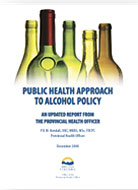 Highlights from the Report
Highlights from the Report
- Data from B.C. show some alarming trends since the rules and regulations governing the sale of alcohol products changed in 2002
- Physical and economic availability of alcohol in B.C. have increased since 2002
- Alcohol consumption has increased by 8% overall since 2002
- Over ¼ of underage youth report binge drinking at least once a month
- Alcohol-related hospital stays have increased moderately since 2002
- Real direct government revenue from the control and sale of alcohol has increased by 4% per year from 2003-2007. However, health and enforcement costs exceeded government revenue from alcohol by approximately $61 million in 2002/2003
- Provincial Health Officer recommends the government continue to actively monitoring alcohol consumption patterns, regularly assess the benefit/cost ratio of alcohol consumption in B.C., and focus on initiatives that will reduce harmful use by youth and young adults
Go back >
The Health and Well-being of the Aboriginal Population - Interim Update (2007) (PDF, 322KB)
This report presents an interim update of selected health status indicators from the 2001 Provincial Health Officer's Annual Report.
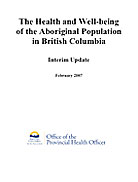 Highlights from the Report
Highlights from the Report
- Improvements in health status for First Nations people are seldom achieved from isolated activities, but instead are the result of longer-term commitments to greater inclusiveness and to addressing the socio-economic determinants of health
- Transformative Change Accord (2005) is an outcome-based plan to close the gaps in education, health, housing, and economic opportunities over the next ten years
- First Nations Health Plan (2006) (PDF, 288KB) builds on the Accord with 29 specific actions in four areas, with seven key targets
- For all measures of premature mortality examined in this report, Status Indians die at earlier ages and at greater rates than other B.C. residents. This is true for the major disease and injury causes of death, and for the major risk factors of alcohol, drugs, or smoking
- While the trend shows improvement for some of these health indicators in absolute terms for Status Indians, there is a persisting and broadly based gap across multiple indicators that cannot be explained by some specific genetic risk alone, as the causes are varied and rooted in socio-economic disparities and cultural disruption
Go back >
Joint Special Report: Provincial Health Officer and Representative for Children and Youth: Health and Well-being of Children in Care in British Columbia: Educational Experience and Outcomes (2007) (PDF, 1.4MB)
This report is the second in a planned series of four joint special reports on the health and well-being of children in care in British Columbia.
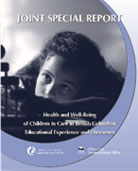 Highlights from the Report
Highlights from the Report
- More than 51% of children in care were identified by the Ministry of Education as having special needs, compared with 8.4% for children who had never been in care
- By age 18, children in care changed schools almost 7 times compared to less than 4 schools for the general population
- Very few children in care (21%) graduate from high school. Those that do graduate have grade point average that is about one letter grade below the general population
- Immediate and systemic action is required as more than half of children in care were not school-ready upon entering Kindergarten and did not meet provincial standards for reading and numeracy skills in grades 4 and 7
- Nine key recommendations are made for the government and policymakers to address gaps in the health and well-being of children in care in British Columbia
Go back >
Evaluation of the Impact of Making HIV a Reportable Infection in B.C. (2006) (PDF, 560KB)
Surveillance of HIV infections has been shown to enhance the prevention and control of HIV/AIDS. Prior to making HIV a reportable infection in B.C., the Provincial Health Officer undertook community consultations in B.C. to inform this decision.
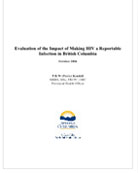 Highlights from the Report
Highlights from the Report
- Trends of HIV testing and rates of HIV positive cases have not changed comparing the periods before and after the introduction of HIV Reporting and follow-up
- Involvement of Public Health in partner elicitation and case management has been well received
- 25-30% of physicians report not informing their patients about critical issues pertaining to HIV reporting during pre-test counselling
- Key recommendations are made regarding appropriate feedback, implementation, communication, ongoing education, development of a domestic violence strategy, and ongoing monitoring, evaluation, and research
Go back >
Joint Special Report: Health and Well-Being of Children in Care in British Columbia (2006) (PDF, 6.1MB)
This report is the first in a planned series arising from a joint initiative of the Child and Youth Officer and the Provincial Health Officer for B.C. The Joint Special Report aims at furthering our understanding of outcomes for children and youth in care by looking at and linking routinely collected data on their use of government-funded services over time.
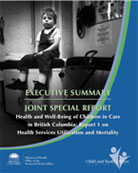 Highlights from the Report
Highlights from the Report
- In 2005, there were 9,080 children in care, accounting for approximately 1% of all children in British Columbia
- The number of Aboriginal children in care was significantly disproportionate where 49% of the total children in care were Aboriginal children even though Aboriginal children constitute only 7% of the general population of children in the province
- Children in care are known to have generally poorer outcomes than children who have never been in care
- Children in care were diagnosed with medical conditions more often, were more frequently prescribed medications, and were admitted to hospitals at a higher rate
- Data for the period of 1986-2005 show the gap between mortality rates for children in care and children in the general population narrowing considerably, but the mortality rate for children in care has remained substantially higher
- As the guardian of these children (through the Director under the Child, Family and Community Service Act), government has a special responsibility to develop strategies to improve these outcomes
- These strategies should be rooted in health promotion and prevention, emphasize early childhood development strategies, and enhance resiliency for high-risk youth
Go back >
Prevention of Falls and Injuries Among the Elderly (2004) (PDF, 2.3MB)
This report examines the impact of falls and injuries on elderly individuals, their families, and society.
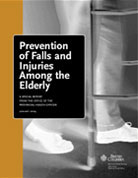
- One in three persons over the age of 65 is likely to fall at least once each year. This means that an estimated 147,000 British Columbians are likely to fall this year
- Over the last decade, there has been no improvement in the rate of deaths from falls
- Number of persons aged 65 and older admitted to hospital due to a fall-related injury has increased
- Injuries from falls account for 85% of all injuries to the elderly and in 1998 cost the province $180 million in direct health care costs
- Setting a target in B.C. of a 20% reduction in falls, as measured by current hospitalization rates for falls among the elderly, would lead to 1,400 fewer hospital stays and 350 fewer elderly people disabled. The overall savings of such prevention could amount to $25 million a year in reduced health care costs
- Recommendations for individuals, seniors' groups, health providers, regional health authorities and the provincial government are outlined to help reduce the toll exerted by falls and the resulting injuries upon our elderly population and our society in general
Go back >
An Ounce of Prevention: a Public Health Rationale for the School as a Setting for Health Promotion (2003) (PDF, 429KB)
This report reviews a strategy to ensure the school curriculum follows best practices, including physical activity and healthy nutrition in Grades 11 and 12.
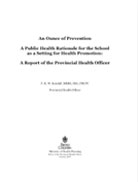 Highlights from the Report
Highlights from the Report
- Adolescence is a time of special risk and adaptation for children where they engage in a range of experimentation behaviours and establish habits of living, nutrition and exercise patterns
- The knowledge, attitudes and behaviours established in childhood and youth have significant implications for behaviours and circumstances in later adult life
- British Columbia has an unprecedented opportunity to take action to address the health status of its youth, and government an opportunity to further address its New Era commitments as the B.C. school health curriculum is open for review and innovation
- B.C. should re-commit to support Healthy Schools initiatives and enhance inter-ministry government initiatives, such as Action Schools!BC, Active BC 2010, the Premier's Sport Award Program and Chronic Disease Prevention Initiatives
Go back >
A Review of Infant Mortality in British Columbia: Opportunities for Prevention (2003) (PDF, 1.2MB)
This report focuses on internationally accepted indicators of child health - infant mortality and low birth weight rates (LBW).
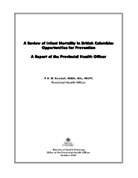 Highlights from the Report
Highlights from the Report
- Infant mortality has been declining for decades in B.C. and reached an historic low of 3.7 deaths per 1,000 live births in the year 2000
- In 2001 and 2002, the infant mortality rate rose to 4.0 and 4.4 deaths per 1,000 live births, respectively
- A large proportion of the excess deaths were due to an increase in 2001 and 2002 in premature, low birth weight infants who are at very high risk
- The LBW rate in B.C. has remained unchanged in the last 16 years. This rate is comparable to other jurisdictions in Canada, but not as low as some European countries
- Status Indian infants have statistically significant increased rate of post-neonatal mortality
- Services such as the Pregnancy Outreach Program (POP) have been established to support at-risk pregnant women in B.C., but only 23% of all mothers of LBW infants receive POP services
- Six key recommendations are made: establish infant mortality goals, develop a long-term tool in effective maternal and child health care services, collaborate and monitor health outcomes of maternal and child health services, emphasize Aboriginal maternal and infant health, and monitor income status of pregnant women.
Go back >
Provincial Health Officer's Report on HIV Reportability (2002) (PDF, 1.0MB)
This report examines the results of a detailed review and a community consultation process, and makes recommendations on HIV reportability in the province.
 Highlights from the Report
Highlights from the Report
- B.C. and Quebec are distinct in Canada as the only provinces that do not require reporting of HIV with identifiers under their public health legislation
- Consultations were initiated with a range of stakeholder groups who almost unanimously opposed reportability
- A review of the current reporting system in B.C. suggests that the main benefits of reportability of HIV in this province would be in the area of partner notification with a potential shortening of the time from infection to diagnosis and treatment/counselling
- HIV should be added to the list of reportable conditions in Schedule A of the Health ActCommunicable Disease Regulation with a non-nominal option for persons being voluntarily tested who do not wish their names to be reported
- Healthcare professionals should be informed of their duty to maintain confidentiality and their duty for informed consent
- Adequate resources must be available and the impact of HIV reportability should be reviewed and evaluated
Go back >
Public Health Approach to Alcohol Policy: A Report of the Provincial Health Officer (2002) (PDF, 113KB)
This review was prompted by recent changes to the rules and regulations governing the sale of alcohol products in B.C.: a liquor reform strategy announced in March 2002 will increase the availability of alcohol.
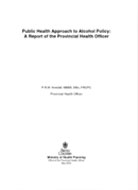 Highlights from the Report
Highlights from the Report
- Government occupies a unique role with respect to alcohol as the regulator, the wholesaler, and the retailer
- With the liquor reform strategy, there may be increases in consumption with increased in the availability of alcohol
- Increases in consumption may be expected to confer some population health benefit from reductions in heart disease and stroke in the older cohort of drinkers
- There is a risk that the increased consumption will occur predominantly in less mature drinkers and exacerbate the trends of increased risky drinking in youth and younger drinking cohorts
- Harms resulting from increased consumption in the younger population of drinkers may outweigh any health benefit to older populations and may cost more than the economic benefits realized through increased sales
- Changes to liberalize alcohol sales should be accompanied by monitoring of public health and safety impacts, increased prevention programming, rigorous enforcement laws, enhancement of the addiction treatment and rehabilitation system, evaluation of prevention policies and programs, and involvement of public health experts in the planning of future changes to alcohol policy
Go back >
Children and Youth in Care: An Epidemiological Review of Mortality, British Columbia, April 1974 to March 2000 (2001) (PDF, 725KB)
This report provides a long-term analysis of the health status of a particularly vulnerable group of children - children and youth in government care.
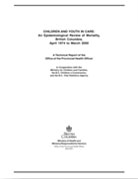 Highlights from the Report
Highlights from the Report
- Children and Youth in Care (CYIC) have higher mortality rates for all cases than the provincial child population
- Children living with disabilities are proportionately over-represented in the CYIC caseload relative to the provincial child population
- Aboriginal children are over-represented in the CYIC caseload relative to the general provincial child population
- The leading causes of CYIC deaths include congenital anomalies, sudden infant death syndrome, motor vehicle collisions, suicides, diseases of the nervous and respiratory systems, accidental poisoning, homicide, infectious disease and cancer
- In order to improve the understanding of the mortality experience and health status of CYIC, we must establish ongoing epidemiological analysis and dataset, assess the feasibility of introducing a standard diagnostic coding of medical conditions to CYIC records, and further consider how best to assess mortality of Aboriginal CYIC
Go back >
Health Status of Children and Youth in Care in British Columbia: What do the Mortality Data Show (2001) (PDF, 336KB)
This report presents death-related trends and patterns among children and youth in government care. It also provides facts about the leading causes of death and strategies for prevention.
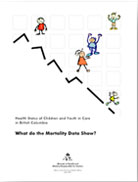 Highlights from the Report
Highlights from the Report
- Over the last 15-year period, death rates have declined among all groups of children an youth, including those in care
- Gaps still exist as those in care had an average annual death that is 3.5 times higher than the provincial rate
- Of the children in care groups, those with a physical disability had by far the highest death rate – almost six times that of children and youth recorded as having “average functioning”
- Early childhood development and prevention programs, public education, good quality child care, and other universal programs play an important role in determining and maintaining children's health
- Every dollar spent to improve the environment for vulnerable children can save $2-7 in health and social costs down the road
- The next steps include establishing an ongoing means to produce death rates for children and youth in care, establishing a minimum data set for analysis of child and youth deaths, adopting the Technical Report's recommendations, and assessing the feasibility of applying this epidemiological approach to the monitoring and analysis of other child health outcomes
Go back >
Antimicrobial Resistance: A Recommended Action Plan for BC (2000) (PDF, 212KB)
This report provides a framework for a B.C. action plan on antimicrobial resistance and summarizes input from a broadly based and interdisciplinary group of experts and stakeholders, including a multi-sectoral provincial steering committee.
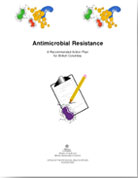 Highlights from the Report
Highlights from the Report
- Antimicrobial resistance occurs when bacteria, viruses, parasites, fungi and other micro-organisms develop the ability to resist drugs designed to kill or inhibit their growth
- Antimicrobial resistance poses a significant and growing threat to public health
- B.C. Antimicrobial Resistance Action Plan Steering Committee was convened by the Provincial Health Officer to meet the need for development of an effective province strategy
- Priorities for provincial action focus on four key areas: surveillance, case management, education and awareness, and animal and agricultural use
- Some of the next steps include developing a proposal for a comprehensive, coordinated surveillance capacity, continuing to develop and implement province-wide standards for screening and infection control, developing a province-wide information campaign, and encouraging the provincial government to pass the Food Safety Act at the earliest opportunity
Go back >
HIV, Hepatitis, and Injection Drug Use in British Columbia Pay Now or Pay Later? (1998) (PDF, 373KB)
This report examines progress to address the epidemic of death and disease resulting from injection drug use in B.C. and recommends actions to pursue provincial goals and objectives related to illicit drugs.
 Highlights from the Report
Highlights from the Report
- For the past decade, British Columbia has had an epidemic of deaths and diseases related to injection drug use (IDU)
- Overdose from IDU has become the leading cause of death for adults age 30-49 in this province with more than 300 deaths annually
- The continuation of this epidemic represents a failure of societal values and attitudes
- Deaths and diseases related to IDU are major causes of avoidable death and disease, leading to the waste of almost $100 million in direct government costs annually in B.C.
- A modest annual expenditure could greatly reduce the death, disease and criminal activity associated with injection drug use
- To truly address the root causes of addiction and particularly IDU, there must be greater commitment to primary prevention, which requires concentrating on early child development and addressing the larger issues of poverty, unemployment, illiteracy, inadequate housing, mental illness, social isolation, violence and abuse, discrimination, and crime
- To pursue B.C.'s Health Goal to “reduce preventable illness, injury, and premature death”, we should establish one authority in B.C. that is responsible for developing and implementing a comprehensive provincial substance abuse strategic plan
